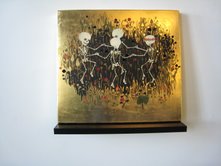Sofia Bilius
Laughing Matter


During a visit in the Anatomical Theatre within the Uppsala University Museum I became inspired to create an exhibition specifically for that space. My idea was to create paintings that would be connected to the original function of the Theatre and feel in some way integrated with the original architecture.
The Anatomical theatre in Uppsala, Sweden is built like an amphitheatre, with a table for post-mortem examinations at its epicenter. The spectators’ gallery is so high and narrow that to reach various viewing levels one’s body has to move in awkward and unusual ways. When I focus on the dissection table where executed 17th century criminals where cut open for the educational benefit of medical students – as well as for paying audiences – the room feels quite creepy. Yet when I move around within the room it often feels joyful. It is also interesting to note that the museum is popular amongst children, and that the Theatre is often appreciated for the beauty of its design.
While researching the literature and imagery of death I became deeply interested in the “Dance Macabre” or “Dance of Death – the late-medieval allegory on the universality of death which emphasized that, regardless of one’s station in life, the dance of death unites us all. I found that making paintings of dancing skeletons allowed me to seamlessly express both the creepiness and the joy of existence. And I’ve found that my dancing skeleton paintings often inspire in viewers the feeling that the deceased are somehow still with us - even in the same room.
This exhibition in Galleri Bergman contains works from my still in-progress series. A larger, more complete version of the series will be exhibited on the walls of the Anatomical Theatre during 2008. As I progressed with painting images of skeletons I discovered other compelling reasons for painting them. To me, they appear quite beautiful and exciting, and I also like their smile, which seems a bit ironical to me. I consider the skeletons in my pictures as people without physical feelings. And yet these figures seem to have a yearning to touch each other. Perhaps it is because they were once alive – and thus know what human touch is.